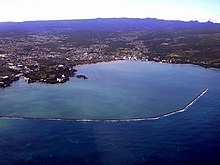생강로캄프사
Stangerochampsa| 생강로캄프사 시간 범위:백악기 후기 S P N | |
|---|---|
 | |
| 국립자연사박물관에 전시된 골격대 | |
| 과학적 분류 | |
| 왕국: | 애니멀리아 |
| 문: | 챠다타 |
| 클래스: | 파충류 |
| 주문: | 악어목 |
| 슈퍼 패밀리: | 악어상과 |
| Clade: | 글로비돈타 |
| 속: | †생강로캄프사 우 외 연구진, 1996년 |
| 모식종 | |
| †스탄게로캄프사맥카베이 우 외 연구진, 1996년 | |
Stangerochampsa는 앨버타주 백악기 후기에 살았던 악어목의 멸종된 속이다.이것은 캄파니아 후기-마스트리히트 시대 말굽 협곡 층에서 발견된 두개골, 부분 아래턱 및 부분 두개골 후골격인 RTMP.86.61.1에 기초하고 있다.Stangerochampsa는 Wu와 동료들에 의해 1996년에 기술되었다.모식종은 S. mccabei이다.총칭은 표본이 발견된 목장의 주인인 Stanger 과의 이름을 따왔으며, 종명은 그것을 발견, 수집, 준비한 James Ross McCabe의 이름을 따왔다.스탄게로캄프사는 "소형"으로 묘사된다; 모형의 두개골은 코끝에서 후두골까지 길이가 20.03cm(7.89인치)이고, 너비는 13.0cm(5.1인치)이고, 허벅지 뼈는 14.2cm(5.6인치)이다.그것은 [2]턱 뒤쪽에 큰 찌그러진 이빨이 있는 이종 치아를 가지고 있었다.
분류
우 교수와 동료들은 계통발생학적 분석을 통해 그들의 새로운 속은 Algnathoschus, Ceratoschus, 그리고 Wannaganoschus를 포함한 악어아과 내의 분지군의 일부로 Brachychampsa, 그리고 Albertochampsa와 Hylaeochampsa에 연속적으로 가장 가깝다는 것을 발견했다.이 배열은 또한 대부분의 중생대 악어와 고생대 [2]악어를 통합한다.Brochu(1999년)는 모든 악어과의 분석에서 Stangerochampsa와 Brachychampsa가 악어과의 바로 바깥에 있다는 것을 발견했고 Stangerochampsa와 Albertochampsa가 [3]동의어라고 제안했다.브로추(2004년)[4]와 힐앤루카스(2006년)[5]도 상게로캄프가 엘리게이터아과 밖에 있다는 것을 발견했다.힐앤루카스는 알베르토챔프를 자매 [5]분류군에게 발견했다.
아래는 Stangerochampsa의 Globidonta [6]내 위치를 보여주는 형태학, 분자학(DNA 배열), 층서학(화석 연령) 데이터를 동시에 사용한 Lee & Yates의 2018년 팁 연대 측정 연구 결과를 바탕으로 한 분지도이다.
| 크로코딜리아 |
| ||||||||||||||||||||||||||||||||||||||||||||||||||||||||||||||||||||||||||||||||||||
한편, Bona et al. (2018)의 계통발생학적 분석에서 Stangerochampsa는 아래 [7]분지도와 같이 악어과, 특히 스템 케이만으로 회수되었다.
| 악어상과 |
| |||||||||||||||||||||||||||||||||||||||||||||||||||||||||||||||||||||||||||||||||||||||||||||||||||||||||||||||||||||||||||||||||||||||||||||||||||||||||||||||||||||||||||||||||||||||||||||||||||||||||||||||
| (시스템 기반 그룹) |
레퍼런스
- ^ Rio, Jonathan P.; Mannion, Philip D. (6 September 2021). "Phylogenetic analysis of a new morphological dataset elucidates the evolutionary history of Crocodylia and resolves the long-standing gharial problem". PeerJ. 9: e12094. doi:10.7717/peerj.12094. PMC 8428266. PMID 34567843.
- ^ a b Wu, Xiao-Chun; Brinkman, Donald B.; Russell, Anthony P. (1996). "A new alligator from the Upper Cretaceous of Canada and the relationships of early eusuchians" (PDF). 39 (2): 351–375. Archived from the original (PDF) on 2011-09-28.
{{cite journal}}:Cite 저널 요구 사항journal=(도움말) - ^ Brochu, C. A. (1999). "Phylogenetics, taxonomy, and historical biogeography of Alligatoroidea". Society of Vertebrate Paleontology Memoir. 6: 9–100. doi:10.2307/3889340. JSTOR 3889340.
- ^ Brochu, Christopher A. (2004). "Alligatorine phylogeny and the status of Allognathosuchus Mook, 1921". Journal of Vertebrate Paleontology. 24 (4): 857–873. doi:10.1671/0272-4634(2004)024[0857:APATSO]2.0.CO;2. JSTOR 4524781. S2CID 85050852.
- ^ a b Hill, Robert V.; Lucas, Spencer G. (2006). "New data on the anatomy and relationships of the Paleocene crocodylian Akanthosuchus langstoni" (PDF). Acta Palaeontologica Polonica. 51 (3): 455–464.
- ^ Michael S. Y. Lee; Adam M. Yates (27 June 2018). "Tip-dating and homoplasy: reconciling the shallow molecular divergences of modern gharials with their long fossil". Proceedings of the Royal Society B. 285 (1881). doi:10.1098/rspb.2018.1071. PMC 6030529. PMID 30051855.
- ^ Paula Bona; Martín D. Ezcurra; Francisco Barrios; María V. Fernandez Blanco (2018). "A new Palaeocene crocodylian from southern Argentina sheds light on the early history of caimanines". Proceedings of the Royal Society B: Biological Sciences. 285 (1885): 20180843. doi:10.1098/rspb.2018.0843. PMC 6125902. PMID 30135152.





